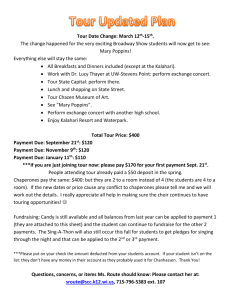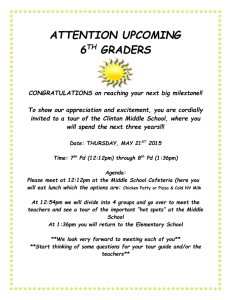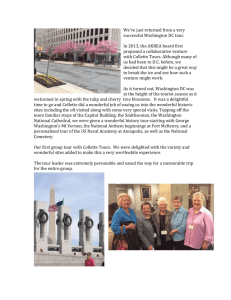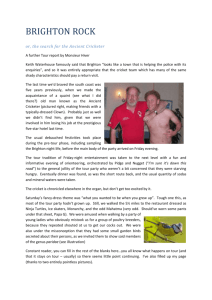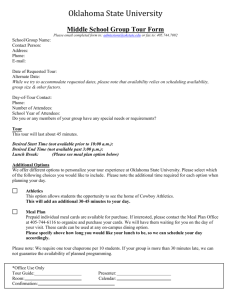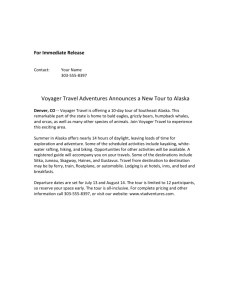Booking a Tour - Texas State University
advertisement
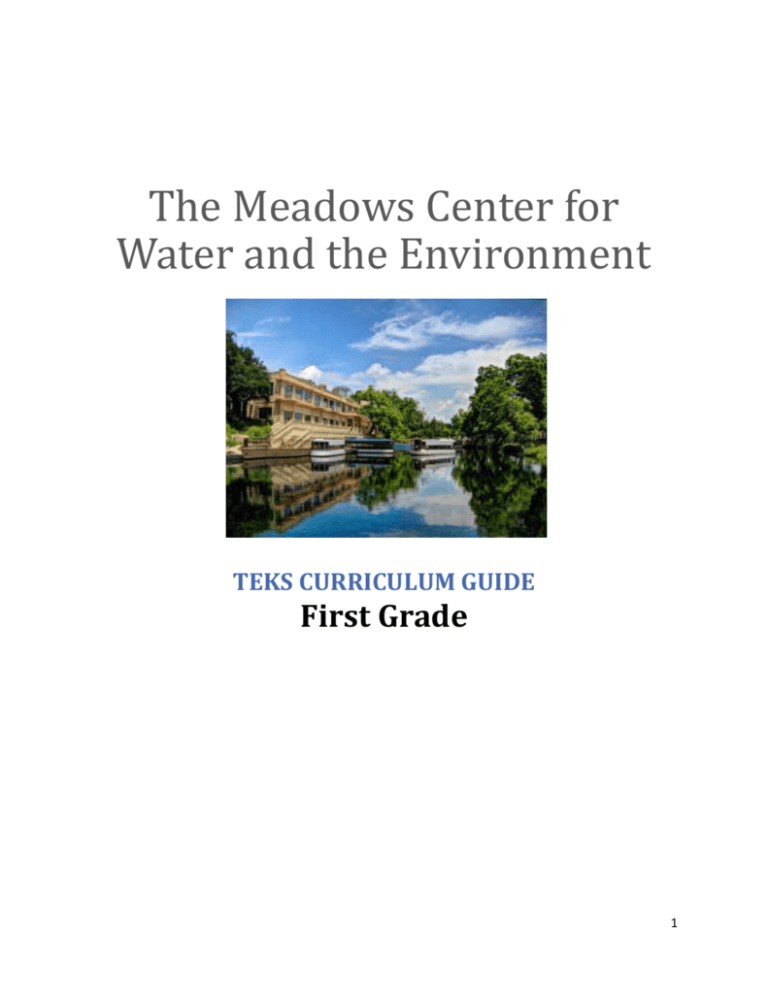
The Meadows Center for Water and the Environment TEKS CURRICULUM GUIDE First Grade 1 The Meadows Center The Meadows Center Educational Tours mission is to provide people of all ages with the ability to recognize Spring Lake as a unique freshwater ecosystem through interpretative interactive experiences that engages the audience in an exploration of interconnections between all living things and water. All tours require a two-week advanced reservation. Tour dates are not guaranteed until your confirmation notice from The Meadows Center Education Office has been processed. The listed group rates apply to any group of 15 people or more. Prices subject to change without notice. Listed prices are for school groups and non-profit organizations. 2 Activities for First Grade 1. Glass-Bottom Boat Ride Length: 30 minutes (can be extended to 45 minutes on request during September-February) As students glide across Spring Lake in glass-bottom boats, they have a rare opportunity to see underwater life from a different perspective. View over 1,000 springs that bubble up 150 million gallons a day of clear water from the Edwards Aquifer to form Spring Lake, the headwaters of the San Marcos River. Declared a critical Habitat by the Federal Government in 1980, Spring Lake is the home of several endangered species. 2. Wetlands Walk Length: 30 minutes Journey over a 1/10 mile floating boardwalk through our wetlands habitat. Students will learn about what wetlands are and what species live in them. Stroll by “Turtle Island” where turtles often sunbathe and birds migrate through. 3. Endangered Species Exhibit Length: 15 minutes Students will see live endangered species on display in this aquarium exhibit. 4. Bug Picking Length: 15 minutes Participants will discover what bugs live in the water at Spring Lake by exploring water samples. 5. Wetlands Bug Bingo Length: 15 minutes This activity goes hand in hand with Bug Picking. Students will learn what different aquatic bugs look like and how to identify them while playing a fun game of “Wetlands Bug Bingo.” (Activity requires reading) 6. All the Water in the World Length: 15 minutes During this interactive activity, students learn how little fresh water is available for use by all living things. 7. The Great Frog Race Length: 15 minutes Oh no! Our pretend wetlands habitat has been polluted with trash. We must race against time to save our frogs one-by-one. This fun obstacle course is sure to be a hit with your Pre-K through early elementary classes. 8. Enviroscape 3D Watershed Model Presentation Length: 30 minutes Students learn about watersheds, and point and non-point source pollution that affects water quality. Students participate in an activity where they put different types of pollution on the ground of the 3D watershed and see how rainfall creates runoff that carries that pollution into rivers and lakes. (Available for schools with 4 or less classes total) 3 Activity connections with Texas Essential Knowledge Standards (TEKS) 1st Grade Science TEKS Applicable Activities (1.1) Scientific investigation and reasoning. The student conducts classroom and outdoor investigations following home and school safety procedures and uses environmentally appropriate and responsible practices. The student is expected to: (A) recognize and demonstrate safe practices as described in the Texas Safety 4, 5, 6, 7, 8 Standards during classroom and outdoor investigations, including wearing safety goggles, washing hands, and using materials appropriately; (B) recognize the importance of safe practices to keep self and others safe and 4, 5, 6, 7, 8 healthy; and (C) identify and learn how to use natural resources and materials, including 1, 2, 3, 4, 5, 6, 7,8 conservation and reuse of recycling of paper, plastic, and metals. (1.2) Scientific investigation and reasoning. The student develops abilities to ask questions and seek answers in classroom and outdoor investigations. The student is expected to: (A) ask questions about organisms, objects, and events observed in the natural 1, 5, 6, 7, 8 world; (B) plan and conduct simple descriptive investigations such as ways objects 1, 5, 6, 7, 8 move; (C) collect data and make observations using simple equipment such as hand 8 lenses, primary balances, and non-standard measurement tools; (D) record and organize data using pictures, numbers, and words; and 4, 5, 6, 7, 8 (E) communicate observations and provide reasons for explanations using 1, 2, 3, 4, 5, 6, 7, 8 student-generated data from simple descriptive investigations. (1.3) Scientific investigation and reasoning. The student knows that information and critical thinking are used in scientific problem solving. The student is expected to: (A) identify and explain a problem such as finding a home for a classroom pet 4, 5, 6, 7 and propose a solution in his/her own words; (B) make predictions based on observable patterns; and 1, 4, 5, 6, 7, 8 (C) describe what scientists do. 4, 5, 6, 7, 8 (1.4) Scientific investigation and reasoning. The student uses age-appropriate tools and models to investigate the natural world. The student is expected to: (A) collect, record, and compare information using tools, including computers, 4, 8 hand lenses, primary balances, cups, bowls, magnets, collecting nets, notebooks, and safety goggles; timing devices, including clocks and timers; non-standard measuring items such as paper clips and clothespins; weather instruments such as classroom demonstration thermometers and wind socks; and materials to support observations of habitats of organisms such as aquariums and terrariums; and (B) measure and compare organisms and objects using non-standard units. 4 (1.7) Earth and space. The student knows that the natural world includes the air around us and objects in the sky. The student is expected to: (B) identify and describe a variety of natural sources of water, including 1, 2, 3 streams, lakes, and oceans; and (C) gather evidence of how rocks, soil, and water help make useful products. 1, 2 (1.9) Organisms and environments. The student knows that the living environment is composed of relationships between organisms and the life cycles that occur. The student is expected to know: (A) sort and classify living and nonliving things based on whether or not they 1, 2, 3, 4, 5 have basic needs and produce offspring; (B) analyze and record examples of interdependence found in various 1, 2, 3, 4, 5 situations such as terrariums and aquariums or pet and caregiver; and (C) gather evidence of interdependence among living organisms such as 1, 2, 3, 4, 5 energy transfer through food chains and animals using plants for shelter. (1.10) Organisms and environments. The student knows that organisms resemble their parents and have structures and processes that help them survive within their environments. The student is expected to: (A) investigate how the external characteristics of an animal are related to 1, 2, 3, 4, 5, 7 4 where it lives, how it moves, and what it eats; (B) identify and compare parts of plants; (C) compare ways that young animals resemble their parents; and (D) observe and record life cycles of animals such as a chicken, frog, or fish. 1, 2, 3, 4, 5, 7 1, 2, 3, 4, 5, 7 1, 2, 3, 4, 5, 7 Additional Materials Additional information on water education can be found on the Texas Aquatic Science website at http://texasaquaticscience.org/. This website provides additional learning opportunities and materials for a variety of subjects concerning water, including “Water is Life”, “Water for the people and the Environment”, “Bays and Estuaries”, and many others. 5 Frequently Asked Questions How do I book a group tour? You may book a tour online at http://www.aquarena.txstate.edu/Educational-Tours/TourReservation-Form.html. If you have questions please call 512-245-7540. Our office hours will vary depending on park traffic, so please leave a message and we will call you back. How far in advance should I book my tour? We require two weeks advance notice for group tours. Please remember the days during March through August can fill up several months in advance, so please book your tour as soon as possible. Do you have a maximum number of students that can attend the field trip? There is not a set maximum number of students per field trip. Your tour-booking agent will discuss the best activities for your group’s size when you book your tour. We recommend booking your tour early for best choice of dates. Do you have a minimum number of chaperones required? One teacher per class is sufficient for our tours. The one required adult should never leave the group alone with the tour guide. You may choose to bring additional teachers and parents if you wish (please check your tour confirmation for fee information). The boats will comfortably seat 25 people each, so additional adults may need to ride on a separate boat than the rest of the group. What age groups are your programs appropriate for? All ages. We customize our programs for your group. I would like to do something different than listed on your website, can you accommodate my group? We try our best to accommodate special requests. Do I need to book a specific time for my tour? Yes, you will book a specific date and time for your tour. Please arrive 15 minutes prior to the start time of your tour. We apologize that we are unable to push back the start times of tours. If your group is late we may need to cut a portion of your tour time. Please call 512-245-7570 and push 0 to notify us that you will be late. What if it rains? If it rains on your tour date you will have the option to reschedule. Please call 512-245-7570 and push 0 on the day of your tour and let a staff member know that your group will not be coming. The boats are enclosed and will still run unless there is lightning. We have limited indoor space so please dress for the weather if it is raining on your tour date. 6 Tour Pricing Information Group Glass Bottom Boat Tour ONLY Students $4.50, Adults $6 (1 free adult per 15 students) Pre K and Kindergarten Tours 1.5 hour Field Trip Students $6, Adults $7 (1 free adult per 10 students) Elementary through Middle School Tours 1.5 hour Field Trip (including a boat tour) Students $6, Adults $7 (1 free adult per 15 students) 2 hour Field Trip (including a boat tour) Students $6.50, Adults $7.50 (1 free adult per 15 students) Longer field trips are an additional $0.50 per half hour Nature Orienteering Plant Scavenger Hunt (6th through 12th) Students $6.50, Adults $7.50 (1 free adults per 15 students) *Maximum of 50 participants 2 hours High School Tours General 1.5 hour tour Students $6, Adults $7 (1 free adult per 15 students) On the Water’s Edge (March —> October) Students $10, Adults $10 (1 free adult per 15 students). *Maximum of 50 participants 2.5 hours Modified On the Water’s Edge (Year Round) Students $6.50, Adults $7.50 (1 free adult per 15 students) 2 hours Booking a Tour Go to http://www.aquarena.txstate.edu/Educational-Tours/Tour-Reservation-Form.html. Web: www.aquarena.txstate.edu Phone: (512) 245-7540 7


